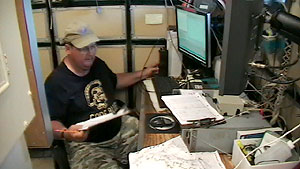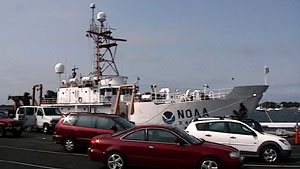

 | |||||||||||
|
|
Journals 2009/2010David Wehunt
August 20, 2009 Latitude: N 36° 30' 734" Today was a busy day on my watch. We started at 6am and had done 4 stations by noon. We ended up working 7 stations with the last two only a half hour apart. Today I got to learn a new job. I controlled the depth the bongo nets go to collect samples. That is actually the easy part. I also have to keep the data collected such as time latitude, longitude, bottom depth and temperature, how long the nets are towed, etc. This involves working two programs and talking to the winch operator who actually controls the bongo nets.
Now I have not talked about everything that happens each day because the days are pretty much the same with a few exceptions. So over the next few days I will talk about things that have happened in the past to give them full justice. Today's topic will be the Delaware II. The Delaware II was built in 1968 as a 150 foot, center-line tow array research vessel. What this means is that there was an opening through the first floor to the bow. The wench was set in the bow region of the ship and the cables ran to the A frame in the stern. This opening was filled in with cabins for the ship master and researchers who sailed on board. The current configuration is shown in the pictures below.
The Delaware II has 3 decks occupied by the crew. The lowest level is half below water and this is where the crew lives, the galley (dining area and kitchen), the food storage and the engine room are located. It's kind of neat eating below sea level. The next level up is where the scientists and ship's master live. Located at this level, which is the deck level, is the wet lab and the dry lab and the electronics area and the specimen freezer. The top level is the bridge and the front deck and on top of the bridge is the flying bridge which leads to the crows nest. The Delaware II is due to be retired from service in 2014. She is a sturdy ship in the NOAA fleet and is manned by a crew mixed with NOAA officers and civilian crew. I will talk more about the crew makeup and the people who occupy those positions at a later date. Student question: How is a research vessel different from other ships? |
||||||||||

